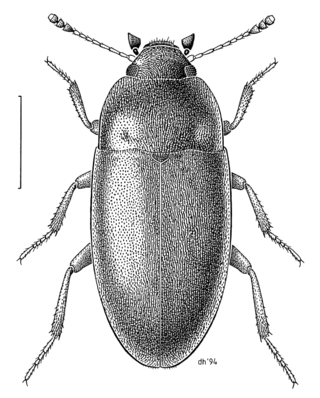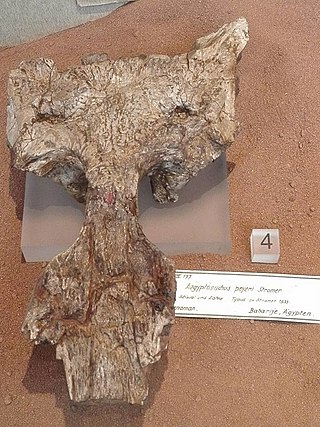
The Phalacridae are a family of beetles commonly called the shining flower beetles, They are often found in composite flowers. They are oval-shaped, usually tan, and about 2 mm in length. Most species feed on fungus, although a number feed on flower heads.

Siphonophorae is an order within Hydrozoa, which is a class of marine organisms within the phylum Cnidaria. According to the World Register of Marine Species, the order contains 175 species described thus far.

Conoidea is a superfamily of predatory sea snails, marine gastropod mollusks within the suborder Hypsogastropoda. This superfamily is a very large group of marine mollusks, estimated at 340 recent valid genera and subgenera, and considered by one authority to contain 4,000 named living species.

The family Archeocrypticidae is a small group of beetles with no vernacular common name, though recent authors have coined the name cryptic fungus beetles. Adults and larvae seems to be saprophagous and are often found in plant litter. Worldwide, about 10 genera and 50 species are found, most species are pantropical. Enneboeus caseyi has been recorded from the American South, Central America, and Mexico. About 20 species are found in Australia, in the genera Enneboeus,Australenneboeus and Gondwanenneboeus,Archeocrypticus,Falsoplatydema, Nothenneboeus, Sivacrypticus and Wattianus. They are largely absent from the Palearctic and Nearctic regions.

Zopherinae is a subfamily of beetles, commonly known as ironclad beetles. Together with the subfamily Usechinae, they have been treated historically as a family, but have recently been joined by several additional taxa, making the Zopheridae a much larger composite family, and the Zopherinae are now only a small component within it, consisting of seven genera in the tribe Zopherini and one, Phellopsis in its own tribe (Phellopsini).

Cicindela, commonly known as common tiger beetles, are generally brightly colored and metallic beetles, often with some sort of patterning of ivory or cream-colored markings. They are most abundant and diverse in habitats very often near bodies of water with sandy or occasionally clay soils; they can be found along rivers, sea and lake shores, sand dunes, around dry lakebeds, on clay banks, or woodland paths.

Cryptophagidae is a family of beetles with representatives found in all biogeographic realms. Members of this family are commonly called silken fungus beetles and both adults and larvae appear to feed exclusively on fungi although in a wide variety of habitats and situations, such as rotting wood and shed animal fur and feathers. These beetles vary from about 1 to 11 millimeters long, and usually have an oval body shape with a slight "waist".

Curculio is a genus of weevils belonging the family Curculionidae and subfamily Curculioninae. Members of the genus are commonly referred to as acorn weevils or nut weevils as they infest the seeds of trees such as oaks and hickories. The adult female weevil bores a tiny hole in the immature nut to lay her eggs, which then hatch into legless grubs. In autumn, the grubs bore holes through the shells from the inside to emerge into the soil where they may live for a year or two before maturing into adults.

The minute tree-fungus beetles, family Ciidae, are a sizeable group of beetles which inhabit Polyporales bracket fungi or coarse woody debris. Most numerous in warmer regions, they are nonetheless widespread and a considerable number of species occur as far polewards as Scandinavia for example.

Aegyptosuchus is an extinct monospecific genus of aegyptosuchid eusuchian crocodyliform. It was found in the Bahariya Formation of Egypt, which dates back to the Cenomanian age of the Late Cretaceous. The type and only species is Aegyptosuchus peyeri.

Melyridae are a family of beetles of the superfamily Cleroidea.

Bembidion is the largest genus of beetles in the family Carabidae by number of species. All species are small and move very fast. Most of them live close to water. The genus has a biantitropical distribution, meaning they are found in both the Northern and Southern Hemispheres, but not in the tropics. In warmer regions it is substituted by closely related Tachys and other genera.

Stenus is a genus of semiaquatic rove beetles in the subfamily Steninae, and one of the largest genera in the kingdom Animalia, with some 3100 known species worldwide. They are predators of Collembola and other small arthropods. Adults have a protrusible labium with a sticky tip used in prey capture. To overcome the rapid escape of Collembola, the labium is protruded at high speed by hemolymph pressure, and immediately withdrawn, pulling the prey within the range of the mandibles. However, the labium tip does not easily stick to prey covered in scales or setae or that have a large body size. Stenus comma is more likely to catch such prey by lunging forward and grabbing them directly with its mandibles rather than using its labium. Stenus species are also known for "skimming" on the water surface using their pygidial gland secretions that act as a surfactant and rapidly propel the beetle fast forward, a phenomenon known as the Marangoni effect. Stenus comma has been seen to achieve a velocity of 0.75 m/s, and to cover a distance of up to 15 m if the secretion is continuous.

Laemophloeidae, lined flat bark beetles, is a beetle family in the superfamily Cucujoidea characterized by predominantly dorso-ventrally compressed bodies, head and pronotal discs bordered by ridges or grooves, and inverted male genitalia. Size range of adults is 1–5 mm (0.04–0.2 in) in length. Currently, it contains 40 genera and about 450 species, and is represented on all continents except Antarctica; species richness is greatest in the tropics.

Borsoniidae is a monophyletic family of small to medium-sized sea snails, marine gastropod mollusks in the superfamily Conoidea.

Rhadine is a genus of beetles in the family Carabidae, containing the following species:

Xylotrechus a genus of longhorned beetles of the family Cerambycidae, containing some 200 described species.

The Aleocharinae are one of the largest subfamilies of rove beetles, containing over 12,000 species. Previously subject to large-scale debate whether the subfamily deserved the familial status, it is now considered one of the largest subfamilies of rove beetles.

Limnichidae, commonly called minute marsh-loving beetles, is a family of beetles belonging to Byrrhoidea. There are at least 30 genera and 350 described species in Limnichidae. They are found worldwide, with the greatest diversity in tropical regions. Most species seem to be associated with water-adjacent habitats, such as riparian and coastal locations, though many species are likely fully terrestrial, with some species being associated with leaf litter and arboreal habitats. Species with known diets feed on moss or algae. The oldest fossils of the family are known from mid-Cretaceous Burmese amber from Myanmar.

Cytilus is a genus of pill beetles in the family Byrrhidae. There are about eight described species in Cytilus.




















